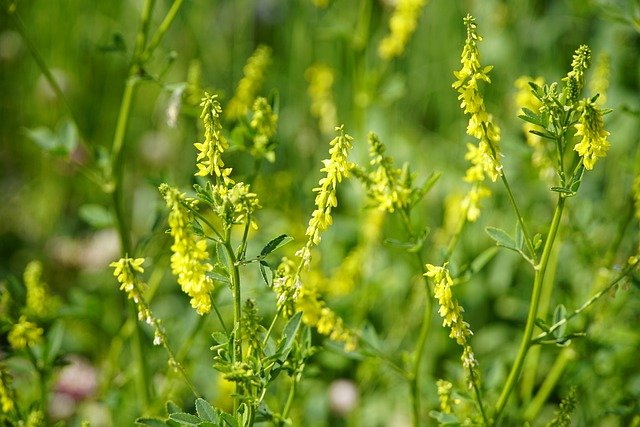
Perhaps known, when it is known, due to its effectiveness against cellulite, the Sweet Clover plant has many other properties and can be considered a medicinal plant. It also grows spontaneously, but since it’s so useful you can cultivate it and we’ll see how.
Sweet clover: characteristics
Belonging to the Leguminosae family, the Sweet Clover is an annual and biennial herbaceous plant with erect stems from which alternate elongated and trifoliate leaves emerge. In spring it produces flowers that are grouped in a spike, axillary and of a beautiful yellow color. The fruit also appears further ahead, which has the shape of a legume with a “bare” surface, usually green when it reaches a good state of ripeness.
It grows in Italy and also throughout Europe, especially in places with the sun, uncultivated, in areas where the climate is temperate. In ancient times it grew in the countryside and was mainly used to create garlands with its long stems, garlands that were placed on the heads of women for decorative purposes. Similar but smaller wreaths were also placed in the closets as a deterrent against moths that even centuries ago came to damage clothes.
Sweet clover: properties
The main properties of this plant concern circulation and water retention problems. The interesting substances are mainly preserved in the leaves and flowers, substances such as flavonoids, tannins and coumarin glycosides which release coumarins. They all have a draining effect that unites them but coumarin is also able to reduce the demolition of catecholamines, in particular of adrenaline. This has benefits for blood vessels that increase their ability to contract because catecholamines are powerful vasoconstrictors. The Melitolo also has a vasoprotective effect, so it increases the permeability of the walls of the veins.
This makes it a remedy for those diseases that affect the veins and varices. Among the disorders for which it is prescribed we find for example venous and lymphatic insufficiency with the presence of edema and swelling in the lower limbs, water retention, varicose veins, phlebitis, heavy legs, hemorrhoids and the dreaded cellulite.
When you take the melitol it is done for internal use and an infusion is prepared with a tablespoon of dried leaves to be left to infuse in a cup of water for about ten minutes. Sipping it hot, we will benefit from its draining and vasoprotective properties. Alternatively we can get the mother tincture of sweet clover to be taken 2 times a day, away from meals, 30 – 40 drops each time in water, or the dry extract capsules always twice a day between meals.
Among the possible side effects of sweet clover is headache which can occur accompanied by nausea and diarrhea. It is not recommended to use sweet clover as a remedy during pregnancy and breastfeeding, we avoid giving it to children under 10 years old.
Sweet clover water for the eyes
Among the products based on sweet clover there is also the treatment for the eyes, sweet clover water. It is one of those little-known natural remedies that never give up once tried. It acts as eye drops and is indicated forconjunctival inflammations and for styes.
Sweet clover: cultivation
Being a plant that also grows spontaneously, it is not very difficult to cultivate it, just follow a few simple rules. It is annual and loves soils that are not too humid and hilly, possibly with little limestone. Better if you have been cultivating legumes that have enriched it with the substances it needs
Towards the end of autumn or at most at the end of winter we can sow, forming rows. If we have a lot of land available we can use a grain seeder. By the middle of July the plants will have reached maturity and will be ready for the big harvest so a mower may be needed. To prevent the leaves and flowers from fermenting, they must be dried immediately. Let us remember that it should absolutely not be given to livestock as forage because it is toxic, but it is perfectly fine as a green manure plant because it releases a lot of nitrogen. A lot of good honey is also obtained from the sweet clover.
Sweet clover against cellulite
Cellulite is linked to circulatory problems so it is part of the problems that the sweet clover can solve since it is effective against water retention, the same goes for orange peel skin.
Thanks to the anti-edematous and anti-inflammatory properties of its leaves, if taken this plant increases the lymphatic flow and improves the situation. As always, we must not misunderstand: acting on cellulite does not mean losing weight and in fact, even in this case no weight loss is expected unless it is due to the decrease in water retention. To lose kilos you need a low-calorie diet, there are no tricks.
Sweet clover can be taken for internal use orally or for external use with ointments and poultices. It may happen that we are advised to associate this herb with others such as centella which has the same positive effect on blood circulation and acts on swelling and a sense of heaviness in the lower limbs.
Variety of Sweet Clover
For the moment we have carefully analysed the variety of sweet clover that is best known, as anti cellulite as well as eye drops, with the recommended water. There are also others, less used in the pharmaceutical field and therefore less known.
To make the honey we have mentioned, but which is not easily found on the market, it is better to use Melilotus alba, particularly rich in nectar, for example. If, on the other hand, you want a decorative plant, you have to go in search of Melilotus coeruleus, with its beautiful bright blue flowers. It is also used, just think, to flavour a local cheese, it came from Asia Minor in the 16th century and has never been widespread.






